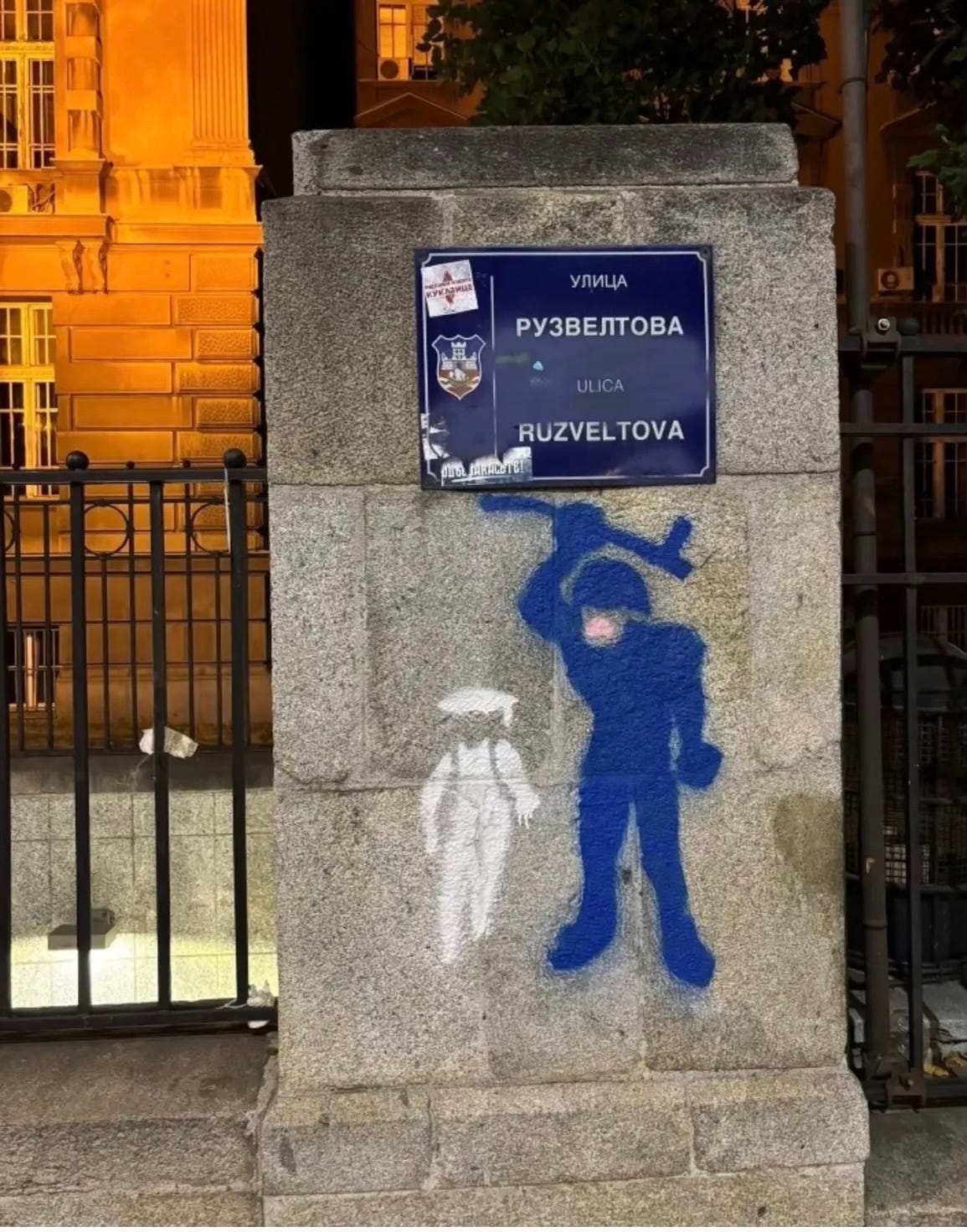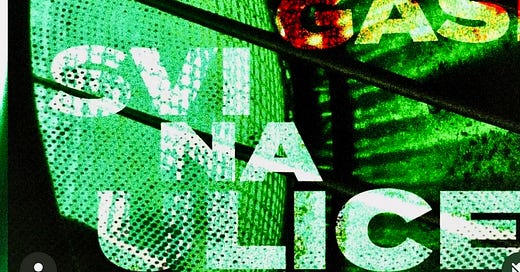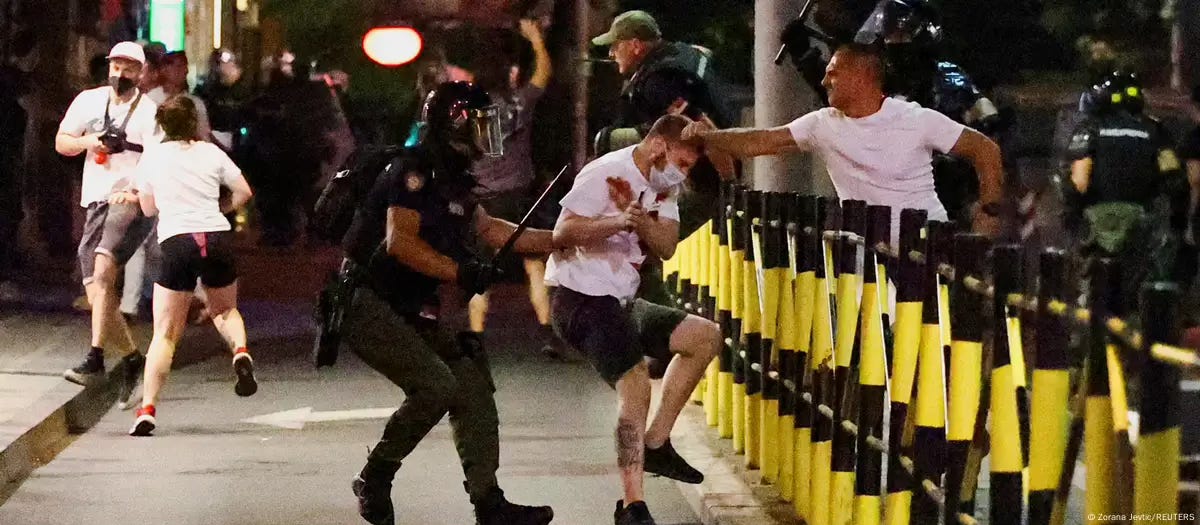
Last weekend my phone rang early on Sunday afternoon. It was a friend of mine back in Tasmania. He wanted to know if I was ok, because I am in Serbia right now – and he’d just seen a short news grab about the most recent anti-government demonstration in Belgrade the night before, organised by students in their eighth month of protests. This 28 June demonstration at the Slavija traffic roundabout attracted around 140 000 people and was held on Vidovdan, an important national holiday in Serbia that commemorates the Battle of Kosovo against the Ottoman Empire in 1389.

As they had promised, the students wrapped up their protest mid-evening, after a series of speeches. The informed the crowd that the government had not met their demand to call early elections, which are due in December 2026. They then invited the citizens of Serbia to continue what they had started, with their push for change since November last year – I’ve earlier described those protests here and here on Natasha’s Belgrade Apartment – and greenlighted a national campaign of peaceful civil disobedience. As also promised, by Serbia’s current President Aleksandar Vučić, the night did not end without the state using force on the streets of Belgrade. Hooligan provocateurs allegedly allied with his administration failed to generate attacks by students and other citizens on the massed lines of helmeted riot police with shields and batons (known as Žandarmerija, or Gendarmerie) stationed between Slavija and the so-called Ćacilend encampment of government supporters in front of the Serbian Parliament. The riot police then advanced to push the protesters back. The night saw beatings, hospitalisation and arrest of many protesters, and a high speed vehicle charge by a convoy of black security vans on fleeing people at Vojvode Stepe street in Belgrade.
The situation escalated across coming days. Citizens blockaded roads in towns and cities across Serbia, using the large metal dumpsters where people throw their daily garbage – when the government ordered that all bins be removed from Serbia’s second city Novi Sad, people deposited rubbish in front of the ruling SNS party’s political headquarters. Citizens then adopted a strategy of constantly walking across zebra crossings, to prevent traffic flow – one official response was replacing crossings with more traffic lights, policed of course. On Tuesday night, there was considerable violence against protesters outside the Faculty of Law at the University of Belgrade, including against teenage girls, some allegedly brutalised by a masked young woman suspected of being some kind of paramilitary member. Many who beat protesters that night wore masks to hide their identity. They’re locally called fantoms and it’s unclear whether or not these are real police.
That difficult night included an attempt by Gendarmerie to storm the Faculty of Law building, only the second time in history that uniformed and armed people have appeared at its entrances, the first being the Wehrmacht in 1941 during the Nazi occupation of Belgrade. It also included many arrests by uniformed police. More concerning, there were recorded incidents of students being removed from the street by men in civilian clothes – who may be police or who may be mafia thugs, they’ve tended to resist showing their official ID – and driven away in cars without police insignia to unstated locations. That pattern of forced abduction has continued in recent days. Just one target was a high school student from the regional city of Užice, a teenage boy said to be an unusually talented young mathematician who was selected for an internship in CERN in Switzerland.

Even though violence was anticipated, it’s fair to say much of Serbia has been shocked by the way it landed. At least, Serbs who consume the media that considers this to be a use of excessive and unjustified force – rather than sticking to the diet of government-aligned media, portraying the students as a threat to the constitutional order, or even as terrorists or drug addicts. There is growing evidence that some incidents in this past week related to beating of students in detention in particular, have elements of the criminal offence of abuse and torture under Serbian law, and possibly worse.
Concern at these events has been raised publicly by a range of people, in different ways. These have included over thirty members of the Faculty of Law at the University of Belgrade, pointing out the autonomy of that institution is constitutionally guaranteed; the Belgrade Bar Association and the Serbian Bar Association, whose members are providing free legal advice to arrested students and citizens (it seems other defence costs will be met by the US-based Alek Kavčić Foundation); over eighty former and active members of the Ministry of Internal Affairs, a numerically tiny drop in a very large ocean; the Dean of the Faculty of Dramatic Arts at the University of Belgrade, who wept on camera in his description of the detention of professors, students and associates of his faculty, some without warrant or any stated legal basis; Vladika Grigorije, the Serbian Orthodox Bishop of Dusseldorf, who already has strong social media form in terms of supporting the students; Filip Karadjordjević, the hereditary prince of Serbia and Yugoslavia, who relocated to Belgrade from London during COVID and this week repeated his call for peaceful resolution and national unity; and Cardinal Ladislav Nemet, a Hungarian Serb from Zrenjanin who is Catholic Archbishop of Belgrade.
At last, the international media is also paying some more attention. The Economist – still a publication of record and of global gravitas – sniffed something bigger in the wind before the Vidovdan protest, and ran a story about the Serbian situation on 16 June. Immediately after the Vidovdan violence, German-language media across Europe gave the situation the most extensive coverage. The early consensus of the German and Austrian press was the weekend’s events showed the Vučić government has nothing to do with proclaimed European values – also noting that Vučić, not the students, enjoys the support of the European Union. The Frankfurter Rundschau described Vučić as ‘authoritarian’ and ‘tightening the screws of repression’, but asserted that he is no longer the ‘undisputed puppeteer’, but now is unable to calm the ‘rebellious country’. The publication further stated, ‘Instead, he is increasingly losing patience and compass in the declared war against the “colored revolution”, which is supposedly being managed from abroad,’ and concluded, ‘Serbia is facing a hot summer and a stormy autumn.’ Vienna’s Die Presse covered both the Serbian protest and those in Hungary, where that weekend there was record attendance at the Pride Parade despite Prime Minister Viktor Orban’s strong objections. It was of the view that this part of Europe is plagued by ‘authoritarian tendencies, pro-Russian populists, the breakdown of the division of power and corruption’, and disenchantment with the European Union. Das Tageblatt in Luxembourg went further, claiming that Vučić is beginning to resemble Belarusian President Aleksandar Lukashenko – ‘There is no point of contact with European values in the way the Belgrade ruler treats increasingly strong and justified criticism of widespread corruption and nepotism,’ and referencing police beatings and arrests, as well as expulsion of foreign visitors who have expressed support for the students. Das Tageblatt claimed the European Union relies on Vučić because of the ‘false hope that this political chameleon will contribute to the solution of the Kosovo issue’ and provide lithium to the European automotive industry, concluding that members of the European Union ‘have enough opportunities to distance themselves from the Belgrade gravediggers of democracy, but action is awaited. Because Europe can no longer afford to be only an observer in Serbia.’

Bizarrely, the influential Frankfurt Allgemeine Zeitung later cruelled that pitch by describing the students’ Vidovdan gathering as a manifestation of the rise of ‘Greater Serbia’ ultranationalism in the style of 1990s leader Slobodan Milosević. The full lineup of speakers probably wasn’t to the taste of every demonstrator (not an homogenous crowd), and some of them spoke too long, which is an unfortunate cultural habit here. But given the larger domestic stakes and context – and the fact there’s no whiff of ‘Greater Serbia’ in any ongoing messaging around civil disobedience, plus the subsequent arrest of a number of the speakers – one might wonder which paid piper was playing whose editorial tune.
So am I ok, Tasmania?
Yes. Last week was exceedingly rough for many people I know and respect here. All kinds of people. Listening to and observing them, I learnt something extra about cycles of fear and love, despair and determination. The unrest and the arrests and probably the violence are set to continue. Yet Serbs are astoundingly resilient – and impossibly witty with it. For me there is some consolation around Wimbledon coming back on our screens at just the right time, with Serbian tennis great Novak Djoković back in form on that career-making green English grass he still prizes most highly. After being foully defamed and trolled back home in Serbia for supporting the student protests during the Australian Open earlier this year, without fanfare Djoković has decided to relocate his family base to Athens. He was also ‘punished’ by being passed over as mascot for the proposed EXPO 2027 in Belgrade – a high profile and priority project of the Vučić government – in favour of fellow Olympic gold medallist, retired Jamaican sprinter Usain Bolt.
Now entering Round Four of this tournament, after each match Djoković has smilingly offered a pumpaj! gesture. Pumpaj! has been one of the key slogans of Serbia’s students in their protests – and Djoković has joked that he and his kids are choreographing his victory dance around it, if he is lucky enough to land Wimbledon one more time.
While you may still be sleeping.




